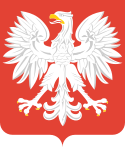
Back وزارة الأمن العام في بولندا Arabic Ministerstwo Bezpieczeństwa Publicznego German Υπουργείο Δημόσιας Ασφάλειας (Πολωνία) Greek Ministère de la Sécurité publique (Pologne) French Ministerstwo Bezpieczeństwa Publicznego Polish Ministério da Segurança Pública da Polônia Portuguese Министерство общественной безопасности (Польша) Russian Міністерство громадської безпеки (Польща) Ukrainian
| Ministerstwo Bezpieczeństwa Publicznego | |
 Coat of Arms of Polish People's Republic used by the UB as its official logo | |
| Agency overview | |
|---|---|
| Formed |
|
| Preceding agency |
|
| Dissolved |
|
| Type | Secret police, counterintelligence, border security, criminal investigations |
| Jurisdiction | Poland |
| Headquarters | Warsaw, Polish People's Republic |
| Employees | 10,000 employees (1945)[1] |
| Agency executive |
|
| Parent agency | National Security Commission, from 1949 Commission of the Secretariat of the Political Bureau of the Central Committee of the Polish United Workers Party for Public Security |
| Child agencies | |

The Ministry of Public Security (Polish: Ministerstwo Bezpieczeństwa Publicznego), was the secret police, intelligence and counter-espionage agency operating in the Polish People's Republic. From 1945 to 1954 it was known as the Security Office (Urząd Bezpieczeństwa, UB), and from 1956 to 1990 as the Security Service (Służba Bezpieczeństwa, SB).[2]
The initial UB was headed by Public Security General Stanisław Radkiewicz and supervised by Jakub Berman of the Polish Politburo. The main goal of the Department of Security was the swift eradication of anti-communist structures and socio-political base of the Polish Underground State, as well as the persecution of former underground soldiers of the Home Army (Armia Krajowa) and later anti-communist organizations like Freedom and Independence (WiN).
The Ministry of Public Security was established on 1 January 1945 and ceased operations on 7 December 1954. It was the chief secret service in communist Poland during the period of Stalinism. Throughout its existence, the UB was responsible for brutally beating, arresting, imprisoning, torturing and murdering at least tens of thousands[3][4] of political opponents and suspects as well as taking part in actions such as Operation Vistula in 1947. The headquarters were located on Koszykowa Street in central Warsaw, but its branches and places of detention were scattered across the entire country, the most infamous being Mokotów Prison.
The Department of Security was replaced by a short-lived Committee for Public Security (1954–1956) and then by a marginally less repressive Security Service (SB) in 1956. All secret servicemen, functionaries, and employees were widely known by the public as Ubecy; in English "Ubeks" and singular "Ubek/Esbek" (pronounced: OO-beck).
- ^ Piotrowski, Tadeusz (December 10, 1998). Poland's Holocaust: Ethnic Strife, Collaboration with Occupying Forces and Genocide in the Second Republic, 1918-1947. McFarland. ISBN 9780786403714 – via Google Books.
- ^ Polish Secret Police, The "Bezpieka": Dossiers of Polish secret police functionaries. DoomedSoldiers.com. Retrieved June 3, 2012.
- ^ Nowak, Jerzy Robert (December 10, 2001). Zbrodnie UB. Wydawn. Maron. ISBN 9788391591819 – via Google Books.
- ^ Szwagrzyk, Krzysztof (December 10, 2005). Prawnicy czasu bezprawia: sędziowie i prokuratorzy wojskowi w Polsce,1944-1956. Instytut Pamięci Narodowej. ISBN 9788388385650 – via Google Books.
{{cite book}}:|work=ignored (help)
© MMXXIII Rich X Search. We shall prevail. All rights reserved. Rich X Search